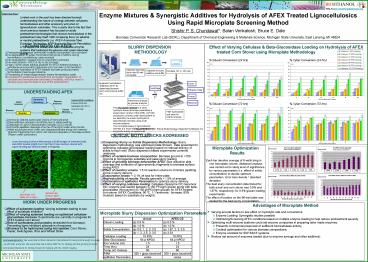Enzyme Mixtures PowerPoint PPT Presentation
1 / 1
Title: Enzyme Mixtures
1
Enzyme Mixtures Synergistic Additives for
Hydrolysis of AFEX Treated Lignocellulosics Using
Rapid Microplate Screening Method
http//www.everythingbioomass.org
Introduction Limited work in the past has been
directed towards understanding the nature of
synergy between cellulases, hemicellulases and
other accessory enzymes on lignocellulosic
substrates. This is partly due to the fact that
much previous research has focused on acidic
pretreatment technologies that remove
hemicellulose in the pretreatment step itself.
With increasing focus on alkaline or neutral
pretreatments (i.e. AFEX-Ammonia Fiber Explosion
Technology, ARP-Ammonia Recycle Percolation,
LHW-Liquid Hot Water) the need to optimize enzyme
systems that hydrolyze the glucans and xylans
becomes critical.
Shishir P. S. Chundawat, Balan Venkatesh, Bruce
E. Dale Biomass Conversion Research Lab (BCRL),
Department of Chemical Engineering Materials
Science, Michigan State University, East Lansing,
MI 48824
- ADVANTAGES OF AFEX
- Pretreatment chemical (ammonia) is easily
recoverable, non-corrosive - No degradation of sugar monomers that act as
inhibitors during fermentation (conditioning
costs avoided) - No neutralization needed prior to enzymatic
hydrolysis - No wash stream AFEX is dry to dry process
- High (gt30) solids loading possible for AFEX
treated biomass in simultaneous enzymatic
hydrolysis and microbial co-fermentation - Enzymatic hydrolysis of AFEX treated biomass
produces easily fermentable mixed sugar streams - Processing of mixed sugar stream lowers
fermentation costs - Compared to traditional acid treatment
synergistic degradation of cellulose and
hemicellulose becomes a necessity, and thus need
to develop enzymes/microbes to suit AFEX
pretreatment
SLURRY DISPENSION METHODOLOGY
Effect of Varying Cellulase Beta-Glucosidase
Loading on Hydrolysis of AFEX treated Corn Stover
using Microplate Methodology
Dispense biomass slurry into 96 well microplate
Dispense enzyme, additive and buffer
Incubate, 50o C, 250 rpm
Eppendorf workstation epMotion 5070" for
dispensing biomass slurry and enzyme-buffer mix
Cover
Centrifuge
Filtration Plate
- UNDERSTANDING AFEX
- Ammonia cleaves acetyl side chains of
hemicellulose - Decrystallizes cellulose microfibrils due to
alkali swelling - Cleavage of Lignin-Carbohydrate Complex (LCC)
bonds - Ammonia assisted cleavage of some of the lignin
ester-ether bonds - Alkali solubilizes short chain xylo-oligosaccharid
es along with cleaved phenolic fragments from
within cell wall and deposits on biomass surface
(Paper under publication)
Frame
Preliminary analysis by glucose analyzer
Typical AFEX Conditions Pressure (20-30 atm),
Temperature (60-120 oC), Time (5-15 mins)
Receiver
The microplate method is a rapid hydrolytic assay
technique (essentially a scaled down version of
the NREL LAP 009 procedure) currently under
development at our laboratory to screen
hydrolysis of lignocellulosic biomass using
multi-enzyme systems. The microplate assay of
lignocellulosic biomass is a more realistic
assessment of enzymatic activity compared with
conventional standard assays (i.e. filter paper
activity) for biomass conversion.
Filter hydrolysate and store for further analysis
Images Modified from Pierce Biotechnology,
Eppendorf Millipore Inc.
- CRITICAL BOTTLENECKS ADDRESSED
- Comparing Slurry vs Solids Dispension
Methodology Slurry dispension methodology was
optimized (Data Shown). Data presented for
optimizing cellulase-glucosidase loading based on
manual delivery of solids to each well. Slurry
dispension based experiments currently underway. - Effect of variable biomass composition Biomass
ground to lt150 microns to homogenize substrate
and ease slurry loading - Effect of grinding biomass before/after AFEX
Size reduction aids cleavage and extraction of
ligno-phenolic fragments to biomass surface
during AFEX - Effect of reaction volume 1.5 ml reaction volume
to minimize pipetting errors in slurry delivery - Evaporation losses lt 0.1 wt loss for entire
plate - Reproducibility of results Results generally lt
5 of average. - Optimization of epMotion Parameters to optimize
slurry delivery. - Effect of varying cellulase loading Cellulase
(Spezyme CP, Genencor Intl.) enzyme was loaded
between 5-150 FPU/gm glucan along with
beta-glucosidase (Novozyme) (0-150 pNPGU/gm
glucan) for AFEX treated corn stover (AFEX
Conditions 90 0C, 11 ammonia biomass, 60
moisture based on substrate dry weight).
Laser Scanning Confocal Microscopy (LSCM) images
of untreated (left) and AFEX treated (right)
Corn Cob Fiber Cross Section stained with Lignin
binding dye Safranin (Work in Progress)
- Microplate Optimization Results
- Each bar denotes average of 8 wells lying in one
microplate column. Statistical analysis was
carried out to study level of significance for
various parameters (i.e. effect of solids
concentration) to decide optimum parameters.
Error bars denote standard deviation. - The best slurry concentration determined for both
avicel and corn stover was 0.5 and 1.67,
respectively, for 0.5 glucan loading
experiments. - The effect of location on the 96-well plate was
studied for the best slurry concentration.
50 mm
50 mm
- WORK UNDER PROGRESS
- Effect of substrate loading Varying substrate
loading to see effect of substrate inhibition - Effect of varying xylanase loading on optimized
cellulase-glucosidase mixtures Experiments are
currently in progress for AFEX treated corn
stover - Role of surfactants and proteins (extracted from
biomass) Preventing lignin inhibitory adsorption
of enzymes - Biomass to be hydrolyzed using microplates Corn
Stover, Poplar, Switchgrass, Rice and Wheat Straw
- Advantages of Microplate Method
- Varying several factors to see effect on
hydrolytic rate and conversions - Enzyme Loading Synergistic studies possible
- Optimizing/Screening AFEX conditions based on
multiple enzyme loading to help reduce
pretreatment severity - Optimizing multi-enzyme systems could aid enzyme
companies in preparing tailor made enzymes - Presently commercial preps lack of sufficient
hemicellulase activity, - Cocktail optimization for various biomass
compositions, - Enzyme cocktails for SSF/SSCF systems
- Reduce net amount of enzymes loaded (due to
enzyme synergy and other additives)
Microplate Slurry Dispension Optimization
Parameters
Acknowledgments We would like to thank Genencor
International for being kind enough to supply us
with their enzymes. We would also like to thank
MBI Intl. for helping with the grinding Process.
And sincere thanks to Dr. Shirley Owens for
helping with the LSCM imaging.

